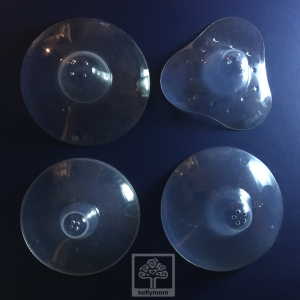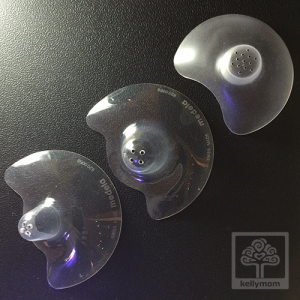What is a nipple shield?
A nipple shield is a flexible silicone nipple that is worn over the mom’s nipple during a feeding. Nipple shields should in general be considered a short-term solution and should be used under the guidance of a lactation consultant.
Often, nipple shields are recommended within the first few days of birth. Frequently in these cases, the shields are not needed and are handed out without proper instructions for using and weaning from them – a shield should generally not be used during the first week after birth unless there is an obvious problem such as prematurity or difficulty latching which is attributable to some physical characteristic of the baby. Here is more information on when baby is not latching on yet , sore nipples, and getting a good start on breastfeeding.
Now infants can get
all their vitamin D
from their mothers’ milk;
no drops needed with
our sponsor's
TheraNatal Lactation Complete
by THERALOGIX. Use PRC code “KELLY” for a special discount!
Disadvantages to using a nipple shield
Disadvantages to the nipple shield include:
- baby may get less milk if the shield is used incorrectly
- mom may be more at risk for plugged ducts and mastitis (if the shield causes reduced milk transfer)
- it can be difficult to wean from the shield
Advantages to using a nipple shield
Although nipple shields should be used only after other options have been tried, it is better to have a baby on the breast with a shield than not on the breast at all!
What type of nipple shield is best?
If you’re using a shield, the thin clear silicon type of nipple shield is the best to use. There is also a variety of shield with a cutout that allows for more skin-to-skin contact than the typical shield. If you’re using a rubber shield, seriously consider getting a silicone one instead. Using a baby bottle nipple on the breast is never a good recommendation.
What precautions should be taken when using a nipple shield?
Here are a couple of things to keep an eye on until baby is weaned from the shield. By following through with the precautions that outlined below, you should be able to avoid or head off any problems:
- When using a shield you’ll need to carefully assess your baby for adequate intake (more here). Count his wet diapers every day and make sure that he’s having at least 6 really wet ones each 24 hour period. You also will want to make sure that he stools at least three times daily if he is less than 5-6 weeks of age. After 5-6 weeks, his stools may come less often, but should still be loose and profuse even if more time has passed. Baby will also need to be weighed frequently – at least every 2 weeks (make sure you use the same scale) – until it is clear that he is gaining well.
- You will also want to listen for frequent swallowing during the feeding and feel for overall good breast softening after the feeding. If your breasts are not well-softened after each feeding, you may need to pump until they are softened to ensure that your supply remains adequate. This will lessen your risk for plugged ducts and help to maintain your supply.
Weaning from a nipple shield
These things can help you start to wean from the shield:
- Ensure good positioning and latch–
- Make sure that when positioning your baby to nurse you are holding him so that his whole body faces yours. He should not have to turn his head to nurse.
- Wait for the baby to open very wide – as with a yawn – before you attempt to latch him on.
- Once he has opened this wide – and it may take patience waiting for him to do so – pull him in real close making sure that he takes as much of the breast into his mouth as possible. His chin and nose should touch your breast. His lips should be flanged out – like a rose petal or a fish’s lips. If they are not, use your finger to flip them out manually.
- Before attempting to feed at all, pump a few minutes. This will elicit let-down so that baby gets a quick reward. It will also elongate the nipple for him.
- Also before feeding, offer him your index or pinky finger nail-side down to suck on for several minutes. This suck-training teaches him to drop his tongue down as he must do with breastfeeding. With the shield (much like a bottle nipple) he may push his tongue to the roof of his mouth to slow the flow of milk.
- Breastfeed frequently – as often as you can. Attempt to feed before he gets too hungry – when he is sucking on his fingers or rooting, but before he cries. If you can catch him early he may be more willing to work with you. You also might try nursing when he is a little drowsy. Some babies are more willing to take the breast when they are semi-asleep than when fully awake.
- Try different nursing positions.
- Nurse while in motion – as you walk, sway, rock, bounce, etc.
- Provide lots of skin-to-skin contact when nursing and at other times as you can. Undress baby to his diaper and remove your blouse if possible. Try nursing while you both enjoy a warm bath.
- Drip expressed breastmilk (or formula, or sugar water if no ebm is available) over your nipple in the corner of the baby’s mouth using an eyedropper or feeding syringe while he is at the breast.
- If baby becomes upset as you are trying, stop and attempt to calm him before trying again.
These last ones pertain more to taking the shield away:
- It may help if you compress your breast and hold it firmly about 1 1/2 inches from the base of your nipple toward the chest wall (usually at the edge of the areola just past where your baby’s lips will be) – like squishing down a big thick sandwich on a roll to take a bite. Holding the breast this way makes your nipple more firm like the shield. Keep holding it like that until it feels like baby is sucking well, and then slowly release the grip.
- Apply ice to your nipple before feeding to harden it.
- Try to notice if there are certain times of the day or positions that he seems more receptive during and build on those.
- Try offering the breast without the nipple shield, particularly when baby is rather sleepy. Sometimes once they take the “bare” breast a couple times, they’ll continue with no problems.
- If baby doesn’t take the breast without the shield relatively easily, give it to him with the shield. DO NOT allow him to become frustrated at the breast, that will only make him more resistant to breastfeeding. Allow baby to build trust that nursing will work and will be ok, even if that means using the shield to make it familiar and easy for him. Once he builds trust, start to remove the shield after he has been on for awhile
- After baby is nursing well and let-down has occurred, attempt to remove the shield quickly and relatch baby. Very gradually, start to remove it earlier and earlier in the feeding until you don’t need it at all.
- Sometimes it works to offer the first breast with the shield and the second one without it, if your baby takes both breasts in one feeding.
- In the beginning, you may not want to take away the shield at every feeding so the baby relaxes and doesn’t look for you to remove it every time.
- You may hear the recommendation to cut away the tip of the nipple shield, a little each day, until it’s gone. This is not recommended for silicon shields, because it will leave sharp edges.
Be sure not to make this a battle with the baby, or he will resist more. Don’t obsess with weaning off the shield to the point that you’re robbed of the joy of breastfeeding. As long as your baby is gaining weight well, then you have some time to play with. Keep trying as often as you can, and give it some time. There are some reports of moms continuing to use the shield for their whole breastfeeding experience, but most moms have taken anywhere from 2 days to about 4-5 weeks to accomplish completely weaning from the shield. Be patient with yourself and your baby while you work through this transition.
Finding help
If you’re not already doing so, seriously consider contacting a lactation consultant (IBCLC) or an experienced breastfeeding counselor for one-on-one support. It can be great help to talk to someone face-to-face. Here is how to find breastfeeding help.
More information
Nipple Shield: Friend or Foe? by Nancy Mohrbacher, IBCLC, FILCA
Nipple Shields: life-saver, supply -wrecker or just another tool for nursing mothers? by Jenny Thomas, MD, MPH, IBCLC, FAAP, FABM
Breastfeeding your premature baby with a nipple shield by Paula P. Meier, R.N., DNSc, FAAN
Why do mothers use nipple shields and how does this influence duration of exclusive breastfeeding? by Kronborg H, et al, from Matern Child Nutr. 2016 Jan 21. doi: 10.1111/mcn.12251
The Use of Nipple Shields: A Review. by Chow S, et al, from Front Public Health. 2015 Oct 16;3:236. doi: 10.3389/fpubh.2015.00236.
Nipple Shields: A Review of the Literature by Anne Chevalier McKechnie and Anne Eglash, from Breastfeed Med. 2010 Dec; 5(6): 309–314. doi: 10.1089/bfm.2010.0003
When Baby Does Not Yet Latch by Jack Newman, MD, FRCPC
Latch-on and positioning links @ ![]()
Resources: Is baby getting enough milk? @ ![]()
How to find breastfeeding help links @ ![]()


